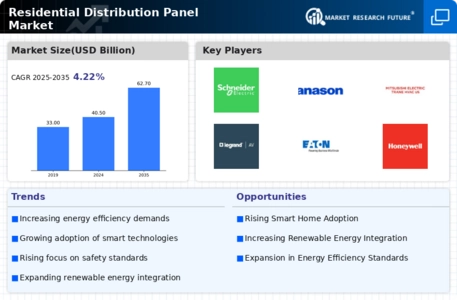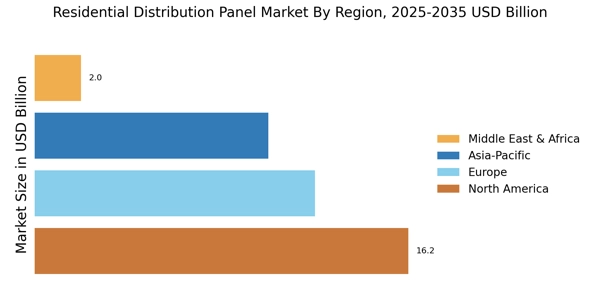Urbanization and Population Growth
Urbanization and population growth are key factors propelling the Residential Distribution Panel Market. As more individuals move to urban areas, the demand for residential housing increases, leading to a higher need for electrical infrastructure. This trend is evident in various regions where new housing developments are being constructed to accommodate growing populations. The Residential Distribution Panel Market must adapt to this surge in demand by providing efficient and reliable distribution panels that can support the electrical needs of modern homes. Furthermore, as urban areas become more densely populated, the complexity of electrical systems increases, necessitating advanced distribution solutions that can manage higher loads and ensure safety.
Regulatory Changes and Energy Standards
Regulatory changes and evolving energy standards are significant drivers of the Residential Distribution Panel Market. Governments and regulatory bodies are implementing stricter energy efficiency standards and safety regulations, compelling manufacturers to innovate and comply. These regulations often require the integration of advanced technologies in distribution panels to meet new performance criteria. As a result, manufacturers are investing in research and development to create products that not only comply with regulations but also offer enhanced functionality. The Residential Distribution Panel Market is thus experiencing a shift towards more compliant and efficient products, which are essential for meeting the demands of modern energy consumption and safety requirements.
Growth in Smart Home Technology Adoption
The proliferation of smart home technologies is significantly influencing the Residential Distribution Panel Market. As consumers increasingly adopt smart devices, there is a corresponding need for distribution panels that can support these technologies. Smart home systems require reliable and efficient energy management, which is facilitated by advanced distribution panels. Market data indicates that the smart home market is expected to grow substantially, with millions of households integrating smart devices. This growth drives demand for distribution panels that can seamlessly integrate with home automation systems, allowing for enhanced control over energy consumption and improved user experience. The Residential Distribution Panel Market is thus evolving to meet these technological advancements.
Rising Demand for Renewable Energy Solutions
The increasing emphasis on renewable energy sources is driving the Residential Distribution Panel Market. As homeowners seek to integrate solar panels and other renewable energy systems, the need for advanced distribution panels that can manage and distribute this energy efficiently becomes paramount. According to recent data, the installation of solar energy systems has surged, with millions of homes adopting solar technology. This trend necessitates the development of distribution panels that can handle variable energy inputs and optimize energy usage. The Residential Distribution Panel Market is thus witnessing innovations aimed at enhancing compatibility with renewable energy systems, ensuring that homes can effectively utilize and store energy generated from sustainable sources.
Technological Advancements in Electrical Systems
Technological advancements in electrical systems are reshaping the Residential Distribution Panel Market. Innovations such as digital monitoring, remote control capabilities, and enhanced safety features are becoming standard in modern distribution panels. These advancements not only improve the efficiency of energy distribution but also enhance safety and reliability. Market analysis suggests that the introduction of smart distribution panels, which can communicate with other devices and provide real-time data, is gaining traction. This trend indicates a shift towards more intelligent electrical systems that can adapt to changing energy demands. The Residential Distribution Panel Market is thus positioned to benefit from these technological innovations, which are likely to become increasingly prevalent.


















Leave a Comment